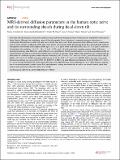| dc.contributor.author | Gerlach, Darius A. | en_US |
| dc.contributor.author | Marshall-Goebel, Karina | en_US |
| dc.contributor.author | Hasan, Khader M. | en_US |
| dc.contributor.author | Kramer, Larry A. | en_US |
| dc.contributor.author | Alperin, Noam | en_US |
| dc.contributor.author | Rittweger, Joern | en_US |
| dc.date.accessioned | 2017-07-24T18:34:37Z | |
| dc.date.issued | 2017 | en_US |
| dc.identifier.citation | Gerlach, Darius A., Karina Marshall-Goebel, Khader M. Hasan, Larry A. Kramer, Noam Alperin, and Joern Rittweger. 2017. “MRI-derived diffusion parameters in the human optic nerve and its surrounding sheath during head-down tilt.” NPJ Microgravity 3 (1): 18. doi:10.1038/s41526-017-0023-y. http://dx.doi.org/10.1038/s41526-017-0023-y. | en |
| dc.identifier.issn | | en |
| dc.identifier.uri | http://nrs.harvard.edu/urn-3:HUL.InstRepos:33490870 | |
| dc.description.abstract | More than half of astronauts present with significant neuro-ophthalmic findings during 6-month missions onboard the International Space Station. Although the underlying cause of this Microgravity Ocular Syndrome is currently unknown, alterations in cerebrospinal fluid dynamics within the optic nerve sheath may play a role. In the presented study, diffusion tensor imaging was used to assess changes in diffusivity of the optic nerve and its surrounding sheath during head-down tilt, a ground-based model of microgravity. Nine healthy male subjects (mean age ± SD: 25 ± 2.4 years; mean body mass index ± SD: 24.1 ± 2.4 kg/m2) underwent 5 head-down tilt conditions: −6°,−12°, −18°,−12° and 1% CO2, and −12° and lower body negative pressure. Mean diffusivity, fractional anisotropy, axial diffusivity, radial diffusivity were quantified in the left and right optic nerves and surrounding sheaths at supine baseline and after 4.5 h head-down tilt for each condition. In the optic nerve sheath, mean diffusivity was increased with all head-down tilt conditions by (Best Linear Unbiased Predictors) 0.147 (SE: 0.04) × 10−3 mm2/s (P < 0.001), axial diffusivity by 0.188 (SE: 0.064) × 10−3 mm2/s (P < 0.001), and radial diffusivity by 0.126 (SE: 0.04) × 10−3 mm2/s (P = 0.0019). Within the optic nerve itself, fractional anisotropy was increased by 0.133 (SE: 0.047) (P = 0.0051) and axial diffusivity increased by 0.135 (SE: 0.08) × 10−3 mm2/s (P = 0.014) during head-down tilt, whilst mean diffusivity and radial diffusivity were unaffected (P > 0.3). These findings could be due to increased perioptic cerebral spinal fluid hydrodynamics during head-down tilt, as well as increased cerebral spinal fluid volume and movement within the optic nerve sheath. | en |
| dc.language.iso | en_US | en |
| dc.publisher | Nature Publishing Group UK | en |
| dc.relation.isversionof | doi:10.1038/s41526-017-0023-y | en |
| dc.relation.hasversion | http://www.ncbi.nlm.nih.gov/pmc/articles/PMC5479856/pdf/ | en |
| dash.license | LAA | en_US |
| dc.title | MRI-derived diffusion parameters in the human optic nerve and its surrounding sheath during head-down tilt | en |
| dc.type | Journal Article | en_US |
| dc.description.version | Version of Record | en |
| dc.relation.journal | NPJ Microgravity | en |
| dc.date.available | 2017-07-24T18:34:37Z | |
| dc.identifier.doi | 10.1038/s41526-017-0023-y | * |


